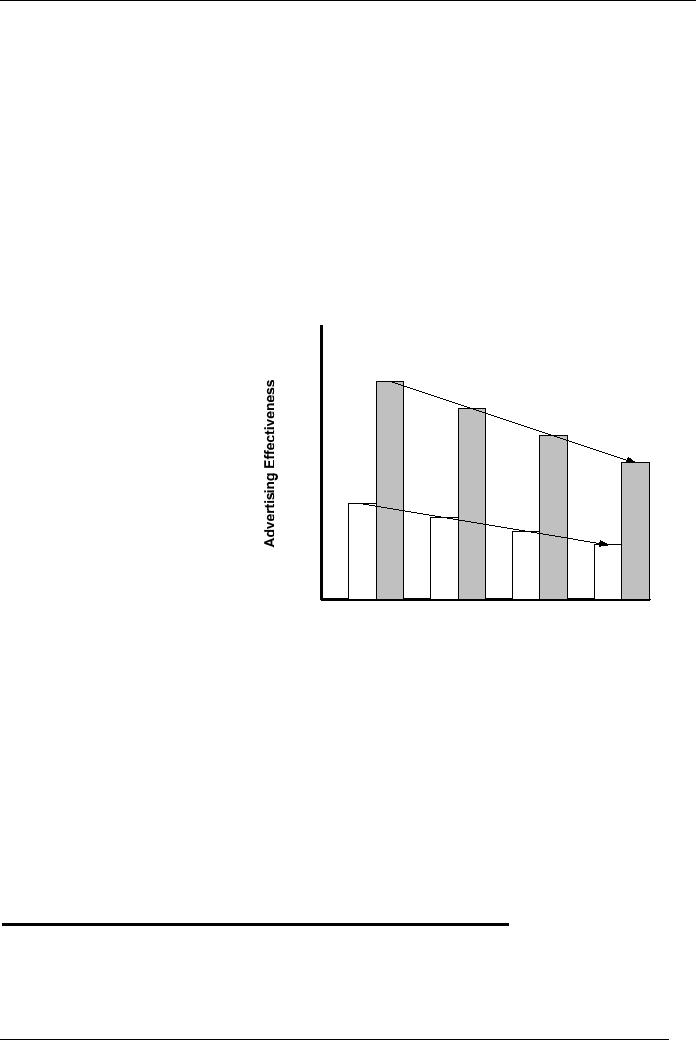 |

Brand
Management (MKT624)
VU
Lesson
34
ADVERTISING
Introduction
This
lecture emphasizes on evaluation of
advertising campaign before it is
launched. Some
basic
considerations are discussed,
which if followed, give you
a decent level of confidence
about
the effectiveness of your
campaign. Having been done
with developing
advertising,
the
lecture
also addresses fundamentals of executing
advertising.
Evaluating
new advertising campaign
This
evaluation does not mean
assessing the impact of a
campaign. It is pre-launch
evaluation
on
the basis of five
fundamental points:
A
strong single basic idea:
A good
campaign revolves around a
strong single idea.
This
single
idea is a reflection of brand's
positioning. Brand's positioning
rests on one strong
benefit,
you will recall! You have to ensure
that good advertising contains a
single idea and
is
not simply a listing of the
virtues of the product.
Selling idea can be based on
the
following
factors when you plan
development and execution of
advertising:
�
It's
new you can talk about
newness.
�
It
offers a solution to a problem. Your
punch line can be based on
this aspect.
�
It is
thought-provoking; it should cause
the consumer to think about
your product
and
develop some attitude and
feelings towards
that.
Natural
growth of the idea:
You have to
make sure that it grows naturally
out of the nature
and
character of the product. It
should capitalize on the
virtues of the product,
which the
consumer
will readily see in the
product. It must
not try to
artificially create an interest
that
may
not be readily related with
the product.
Appeal
to self-interest: It
should appeal quickly to the
self-interest of the consumer.
The
consumer
should associate the product
with some service to him. If
not, then he is not
going
to
have feelings and attitude
toward your brand.
Your
own custom-made approach: The
campaign should follow an approach
that sounds
and
looks like your own. It
should be distinctive in relation to
your positioning and
brand
persona.
It should be memorable in that it can be
readily associated to your
brand and not
those
of competitors.
It
must not wander
off: In
its execution, it must
stick to
the positioning, main
selling idea.
It
must
not wander
off the main selling
point into different
directions? In sticking to
the
main
selling idea, you may
point out the significance
of the promise, offer
reasons why this
promise
is possible, or relate various attributes
to the basic promise. You will
recall from
lecture
20 how to assess the main
attribute/benefit for positioning
from customer's
standpoint.
Miscellaneous
considerations: A few
straightforward considerations must be
taken into
account
while you evaluate
advertising for its
effectiveness. Some of the
following
questions
provide valuable insights and
build up your confidence
about the relevance of
the
campaign:
�
Is it
simple?
135

Brand
Management (MKT624)
VU
�
Does
it reflect the character of
the product?
�
Is
it interesting enough to get
readership?
�
Does
it take advantage of the medium?
�
Does
it demonstrate it point?
�
Is
it specific and thought-provoking?
If
all the points really
represent themselves as campaign
constituents, it is a good campaign
and
reflects
your strategy statement and
copy strategy. And, that is
a reflection that your
positioning
and
persona are well
translated.
Executing
advertising is all about ensuring a
high level of customer
response effects. It
deals
with:
�
Target
market
Advertising
Effectiveness
reach
and
Customer
Response
�
Media
selection
100%
Figure
41
�
Media
coverage
�
Message
frequency
80%
�
Ad
content or
copy,
and value
proposition.
60%
What
we need to learn here is
the
"why-not" factor, that
is,
40%
why
may campaigns
not
generate
the required level of
customer
response? Let's
20%
take
a look at that.
For
any level of
awareness,
the
levels of comprehension,
Purchase
Awareness
Comprehension
Intention
intention,
and purchase are
consecutively
lower. The
Customer
Response
higher
the level of
awareness,
Market-Based
Management by Roger J.
Best
the
higher is the level
of
purchase.
It is also important to note again that
purchase level does not
increase as much as
does
the awareness. The
accompanying graphics illustrate
this fact.
To
have a higher level of purchase, we
have to work hard to jack up
awareness. Building
awareness,
therefore, is the first step
toward building profits. Sustained
loyalty depends on
customer
retention and his coming back and back
for purchasing. It is this
repeat purchasing
that
has a direct relationship
with profitability.
The
basic objective of communication is to
increase awareness among the
target market and not
general
public. A well known and
memorable campaign is no good if it does
not generate the
required
response.
Target
Market Reach - Media
Selection and Customer
Awareness
In
order to reach your target
customers effectively, you
have to have a good understanding
of
their
media habits, like
�
What
TV channels they
watch?
�
What
newspapers and which parts they
are interested in?
�
What
magazines they prefer?
136

Brand
Management (MKT624)
VU
�
What
radio stations and at what
time?
�
How do
they go to work and get exposed to
the outdoor media?
�
Are
they internet users?
All
of the factors have to be considered
before you buy a combination
of media to reach your
target
customers. Everything adds to cost and
the incremental cost has to be
related to the
increment
of economic benefits.
Message
Frequency and Customer
Awareness
Once
you have chosen the media
mix, the next question is
how many times you
should expose
your
target customers to your
message. Doing it too few
times is not going to serve
the
purpose,
for the message may
not make inroads into their
memories.
You
have to decide about the
right frequency to make the
message meaningfully effective
in
terms
of its registration. It could be
"concentrated communication strategy" or
"distributed
communication
strategy"1.
You concentrate generally for
seasonal products and distribute
for
the
ones that generally sell
round the year.
Ad
Copy and Customer Response
We
have learned quite a bit
about the role of the ad
copy toward creating
awareness and
comprehension.
We must be sure that the
message is rightly received and
interpreted at the
customers'
end. One approach is to test the
copy before running it
nationwide, especially if it is
a
TV commercial.
Fragmented
media has given us the advantage of
testing. If the results are
positive in terms of
comprehension
by the target market, you
should go ahead with the
campaign. Needless to say
that
ad copy is best able to attract
customers when it is really
based on customer needs
and
situations
familiar to customers.
Message
Reinforcement
One
hard fact of communication is
that it has to be continuous,
repetitive and reinforcing.
Building
awareness, comprehension, and intention
will bring in a good customer response,
but
will
diminish if the message is
not reinforced. That is
precisely the reason that
you see
advertising
for soaps, ice cream, and cell
phone services almost round
the year.
Maintaining
a high level of awareness is
expensive. One approach to reinforcement
that
maintains
awareness and reduces copy
wear-out is "pulsing", which is
use of alternating
exposure
periods. Other approach is "heavy-up" for
seasonal items.
You
go for pulsing to maintain a
base awareness of your
product throughout the year,
while
heavy-up
its message frequency before
and during the high sales
periods.
Summary
Advertising
should be developed keeping
brand positioning in mind. If
positioning has been
chosen
right after assessing all
the product benefits from
customer's standpoint, then
chances
are
that campaign will be based on
the most appealing benefit
and character of the product.
It
will
be simple and straight forward
with no ambiguities. It should be
very natural not
communicating
anything that does not
belong to the
product.
While
executing advertising, the
customer response effects
should be kept in mind
and
campaign
devised accordingly. Awareness must be
created at a very high level
in order to
achieve
a decent level of purchase by
customers.
The
factors of considering the
target market, message
frequency, and reinforcement should
be
considered
carefully to execute the
campaign effectively.
137

Brand
Management (MKT624)
VU
Bibliography:
1.
Roger J. Best: "Market-Based Management
Strategies for Growing Customer
Value
and
Profitability"; Prentice Hall
(304-309)
Suggested
readings:
2.
Roger J. Best: "Market-Based Management
Strategies for Growing Customer
Value
and
Profitability"; Prentice Hall
(302-322)
138
Table of Contents:
- UNDERSTANDING BRANDS – INTRODUCTION:Functions of Brand Management, Sales forecast, Brand plan
- INTRODUCTION:Brand Value and Power, Generate Profits and Build Brand Equity
- BRAND MANIFESTATIONS/ FUNDAMENTALS:Brand identity, Communication, Differentiation
- BRAND MANIFESTATIONS/ FUNDAMENTALS:Layers/levels of brands, Commitment of top management
- BRAND CHALLENGES:Consumer Revolt, Media Cost and Fragmentation, Vision
- STRATEGIC BRAND MANAGEMENT:Setting Objectives, Crafting a Strategy, The Brand Mission
- BRAND VISION:Consensus among management, Vision Statement of a Fast Food Company, Glossary of terms
- BUILDING BRAND VISION:Seek senior management’s input, Determine the financial contribution gap
- BUILDING BRAND VISION:Collect industry data and create a brand vision starter, BRAND PICTURE,
- BRAND PICTURE:Brand Value Pyramid, Importance of being at pinnacle, From pinnacle to bottom
- BRAND PERSONA:Need-based segmentation research, Personality traits through research
- BRAND CONTRACT:The need to stay contemporary, Summary
- BRAND CONTRACT:How to create a brand contract?, Brand contract principles, Understand customers’ perspective
- BRAND CONTRACT:Translate into standards, Fulfill Good Promises, Uncover Bad Promises
- BRAND BASED CUSTOMER MODEL:Identify your competitors, Compare your brand with competition
- BRAND BASED CUSTOMER MODEL:POSITIONING, Product era, Image Era, An important factor
- POSITIONING:Strong Positioning, Understanding of components through an example
- POSITIONING:Clarity about target market, Clarity about point of difference
- POSITIONING – GUIDING PRINCIPLES:Uniqueness, Credibility, Fit
- POSITIONING – GUIDING PRINCIPLES:Communicating the actual positioning, Evaluation criteria, Coining the message
- BRAND EXTENSION:Leveraging, Leveraging, Line Extension in detail, Positive side of line extension
- LINE EXTENSION:Reaction to negative side of extensions, Immediate actions for better managing line extensions
- BRAND EXTENSION/ DIVERSIFICATION:Why extend/diversify the brand,
- POSITIONING – THE BASE OF EXTENSION:Extending your target market, Consistency with brand vision
- DEVELOPING THE MODEL OF BRAND EXTENSION:Limitations, Multi-brand portfolio, The question of portfolio size
- BRAND PORTFOLIO:Segment variance, Constraints, Developing the model – multi-brand portfolio
- BRAND ARCHITECTURE:Branding strategies, Drawbacks of the product brand strategy, The umbrella brand strategy
- BRAND ARCHITECTURE:Source brand strategy, Endorsing brand strategy, What strategy to choose?
- CHANNELS OF DISTRIBUTION:Components of channel performance, Value thru product benefits
- CREATING VALUE:Value thru cost-efficiency, Members’ relationship with brand, Power defined
- CO BRANDING:Bundling, Forms of communications, Advertising and Promotions
- CUSTOMER RESPONSE HIERARCHY:Brand-based strategy, Methods of appropriations
- ADVERTISING:Developing advertising, Major responsibilities
- ADVERTISING:Message Frequency and Customer Awareness, Message Reinforcement
- SALES PROMOTIONS:Involvement of sales staff, Effects of promotions, Duration should be short
- OTHER COMMUNICATION TOOLS:Public relations, Event marketing, Foundations of one-to-one relationship
- PRICING:Strong umbrella lets you charge premium, Factors that drive loyalty
- PRICING:Market-based pricing, Cost-based pricing
- RETURN ON BRAND INVESTMENT – ROBI:Brand dynamics, On the relevance dimension
- BRAND DYNAMICS:On the dimension of knowledge, The importance of measures
- BRAND – BASED ORGANIZATION:Benefits, Not just marketing but whole culture, Tools to effective communication
- SERVICE BRANDS:The difference, Hard side of service selling, Solutions
- BRAND PLANNING:Corporate strategy and brands, Brand chartering, Brand planning process
- BRAND PLANNING PROCESS:Driver for change (continued), Brand analysis
- BRAND PLAN:Objectives, Need, Source of volume, Media strategy, Management strategy